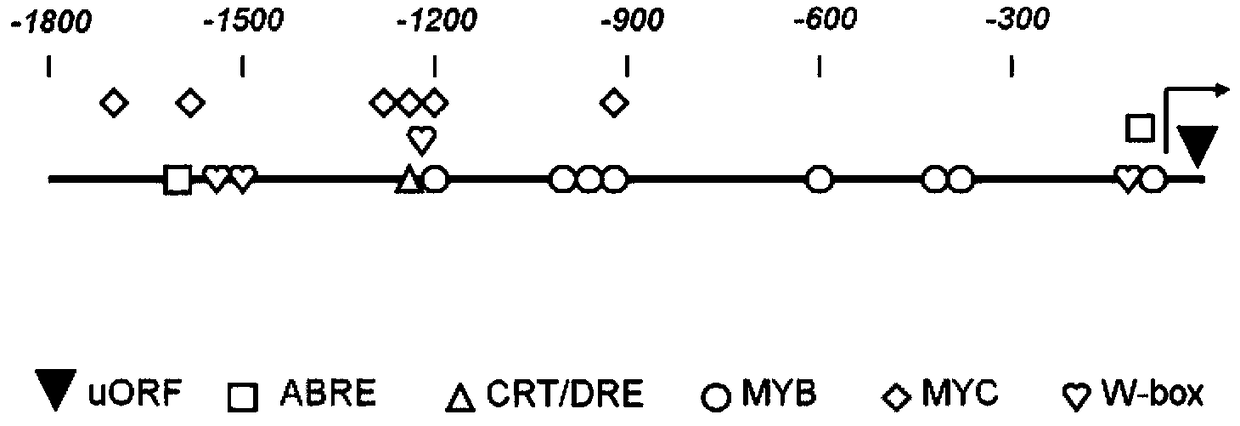A kind of plant inducible promoter and its application
A promoter, inducible technology, applied to plant inducible promoter sequence and its application field in plant stress resistance regulation
- Summary
- Abstract
- Description
- Claims
- Application Information
AI Technical Summary
Problems solved by technology
Method used
Image
Examples
Embodiment 1
[0040] DNA molecules such as 1) or 2) or 3):
[0041] 1) The DNA molecule shown in SEQ ID NO.1 in the sequence listing;
[0042] 2) A DNA molecule that hybridizes to the nucleotide sequence shown in SEQ ID NO.1 in the sequence listing and has promoter activity under high stringency conditions;
[0043] 3) A DNA molecule having more than 65% identity with the nucleotide sequence of 1) or 2) and having promoter activity.
[0044] A method for obtaining the DNA molecule shown in SEQ ID NO.1, comprising the steps of: 1) using the CTAB method to extract wild barley genomic DNA, 2) using the genome walking method to clone the wild barley HbCIPK2 promoter region; step 2) Two rounds of PCR amplification were performed, using two reverse primers SP1 and SP2 respectively, and the SP1 and SP2 primers were the DNA molecules shown in SEQ ID NO.2 and SEQ ID NO.3 in the sequence listing, respectively.
[0045] In this embodiment, the specific steps for obtaining the DNA molecule shown in S...
Embodiment 2
[0061] Application of 1), 2), 3) DNA molecules described in Example 1.
[0062] The biological material related to the DNA molecule described in Example 1 is any one of the following A1)-A6):
[0063] A1) an expression cassette containing said DNA molecule;
[0064] A2) a recombinant vector containing said DNA molecule, or A1) a recombinant vector of said expression cassette;
[0065] A3) a recombinant microorganism containing the DNA molecule, the expression cassette described in A1) or the recombinant vector described in A2);
[0066] A4) a recombinant cell line containing the DNA molecule, the expression cassette described in A1) or the recombinant vector described in A2);
[0067] A5) a transgenic plant tissue containing the DNA molecule, the expression cassette of A1) or the recombinant vector of A2);
[0068] A6) A transgenic plant organ containing the DNA molecule, the expression cassette of A1) or the recombinant vector of A2).
[0069] Use of said DNA molecule as ...
Embodiment 3
[0072] Method for obtaining stress-resistant transgenic plants using the DNA molecules described in Example 1.
[0073] A method for cultivating transgenic plants comprises introducing the DNA molecule and a target gene into plants to obtain a plant in which the target gene is induced by adversity stress and / or ABA-induced expression.
[0074] The method comprises the following steps: 1) Constructing the expression vector proHbCIPK2:GUS driven by the DNA molecule in Example 1; 2) Obtaining a transgenic line by using the expression vector proHbCIPK2:GUS.
[0075] The specific operation method of the step 1) is: use the primers proHbCIPK2-F, proHbCIPK2-R to amplify the DNA molecular sequence in Example 1 by PCR method and introduce restriction sites PstI and XhoI, insert the vector pYBA1121 after sequencing, and construct the obtained The expression vector proHbCIPK2:GUS; the sequences of the primers proHbCIPK2-F and proHbCIPK2-R are respectively the DNA molecules shown in SEQ ID ...
PUM
 Login to View More
Login to View More Abstract
Description
Claims
Application Information
 Login to View More
Login to View More - R&D
- Intellectual Property
- Life Sciences
- Materials
- Tech Scout
- Unparalleled Data Quality
- Higher Quality Content
- 60% Fewer Hallucinations
Browse by: Latest US Patents, China's latest patents, Technical Efficacy Thesaurus, Application Domain, Technology Topic, Popular Technical Reports.
© 2025 PatSnap. All rights reserved.Legal|Privacy policy|Modern Slavery Act Transparency Statement|Sitemap|About US| Contact US: help@patsnap.com



